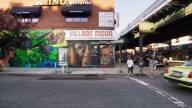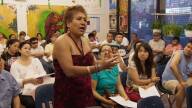Making The Film
Frederick Wiseman describes his experience making 'In Jackson Heights’:
“I have, since I was a child, always been fascinated by the variety of human behavior. As an alleged adult, making documentary films has been, for me, the perfect work. I get to not only record but to try to think about and organize my experience. I have been making an institutional series without any precise definition of institution. ”For 'In Jackson Heights’ I drew an imaginary line around part of the Borough of Queens known as Jackson Heights. In Queens, this is called a neighborhood and the actual boundaries are imprecise. In Jackson Heights, there are167 languages, and communities of people from every country in South and Central America as well as large groups of people from Pakistan, Bangladesh, India, Thailand, Nepal and Tibet. They live together with the descendants of earlier immigrations to America-Italian, Jewish and Irish. The area is a true American “melting pot” reminiscent of the Lower East Side of New York City at the end of the 19th century.
The shooting method was to walk around filming events in the street, going into businesses (stores, laundromats, bakeries, restaurants, supermarkets), religious institutions (mosques, temples, churches) and collecting 120 hours of sequences and shots. When I began I had no idea what the themes, point of view or length would be.
The film emerged from nine weeks of shooting and ten months of editing. In the editing there is a four way conversation going on between (1) my memory of the place; (2) the record of that memory as retained in the rushes; (3) my general experience and (4) the editing process where I try to understand what is going on in an individual sequence, choose and edit the material I want to use and discover visual and thematic connections between sequences. The film finds a form in that conversation and represents what I learned from the experience of making the film.“
Funding provided by the Corporation for Public Broadcasting (CPB), JustFilms/Ford Foundation, Independent Television Service (ITVS), Sundance Institute Documentary Film Program, the Pershing Square Foundation, WGBH Educational Foundation, and by contributions to your PBS station from viewers like you.










































